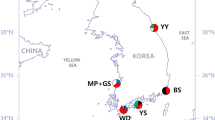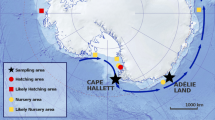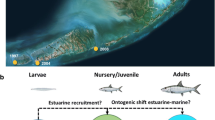Abstract
To examine current genetic-based paradigms pertaining to the structure and possible philopatry of red drum populations, we used solution-based inductively coupled plasma-mass spectrometry (ICP-MS) to analyze the otolith chemistry of juvenile red drum (Sciaenops ocellatus) from eight different estuaries in the Gulf of Mexico (Gulf) and the North Atlantic Ocean. One estuary (Tampa Bay, Fla.) was sampled in three different years. Analyses of variance for five elemental ratios (Mg/Ca, Mn/Ca, Zn/Ca, Sr/Ca, Ba/Ca) were all significantly different between estuaries, as was a multi-element signature (MANOVA, Pillai’s trace F 50, 1020=19.41, P<0.0001). We also found that red drum from the Gulf could be distinguished from those taken from the Atlantic Ocean with 99.5% accuracy, likely due to differences in water chemistry between these water masses. A discriminant function developed using these elemental ratios was more than 80% accurate in assigning juvenile red drum to their natal estuary, or in the case of Tampa Bay, to the correct year of spawning. We also used laser ablation ICP-MS to examine the otolith core chemistry of adult red drum collected from spawning aggregations near Tampa Bay. Using a discriminant function analysis with a calibration data set derived from juvenile signatures, we found that 75% of the adult cores matched the juvenile signal established for Tampa Bay 1982. Although preliminary, the results presented here suggest that red drum may return to their natal estuary to spawn, which has been postulated from genetic data.


Similar content being viewed by others
References
Bass DG, Cox DT (1985) River habitat and fishery resources of Florida. In: Seaman WJ (ed) Florida aquatic habitat and fishery resources. Special publication of the Florida Chapter. American Fisheries Society, Kissimmee, Fla., pp 121–187
Bath GE, Thorrold SR, Jones CM, Campana SE, McLaren JW, Lam JWH (2000) Strontium and barium uptake in aragonite otoliths of marine fish. Geochim Cosmochim Acta 64:1705–1714
Buechner M (1987) A geometric model of vertebrate dispersal: tests and implications. Ecology 68:310–318
Church TM (1986) Biogeochemical factors influencing the residence time of microconstituents in a large tidal estuary, Delaware Bay. Mar Chem 18:393–406
Cutter GA (1991) Trace elements in estuarine and coastal waters—U.S. studies from 1986–1990. Rev Geophys S29:639–644
Del Castillo CE, Coble PG, Conmy RN, Muller-Karger FE, Vanderbloemen L, Vargo GA (2001) Multispectral in situ measurements of organic matter and chlorophyll florescence in seawater: documenting the intrusion of the Mississippi River plume in the West Florida Shelf. Limnol Oceanogr 46:1836–1843
Dove SG, Gillanders BM, Kingsford MJ (1996) An investigation of chronological differences in the deposition of trace metals in the otoliths of two temperate reef fish. J Exp Mar Biol Ecol 205:15–33
Edmonds JS, Lenanton RCJ, Caputi N, Morita M (1992) Trace elements in the otoliths of yellow-eye mullet (Aldrichetta forsteri) as an aid to stock identification. Fish Res 13:39–51
Everitt BS, Der G (1998) A handbook of statistical analyses using SAS. Chapman & Hall/CRC Press, Boca Raton, Fla.
Farrell J, Campana SE (1996) Regulation of calcium and strontium deposition on the otoliths of juvenile tilapia, Oreochromis niloticus. Comp Biochem Physiol A 115:103–109
Fowler AJ, Campana SE, Jones CM, Thorrold SR (1995) Experimental assessment of the effect of temperature and salinity on elemental composition of otoliths using solution-based ICPMS. Can J Fish Aquat Sci 52:1421–1430
Gillanders BM (2002) Temporal and spatial variability in elemental composition of otoliths: implications for determining stock identity and connectivity of populations. Can J Fish Aquat Sci 59:669–679
Gillanders BM, Kingsford MJ (1996) Elements in otoliths may elucidate the contribution of estuarine recruitment to sustaining coastal reef populations of a temperate reef fish. Mar Ecol Prog Ser 141:13–20
Gillanders BM, Kingsford MJ (2000) Elemental fingerprints of otoliths may distinguish estuarine “nursery” habitats. Mar Ecol Prog Ser 201:273–286
Gillanders BM, Kingsford MJ (2003) Spatial variation in elemental composition of otoliths of three species of fish (family Sparidae). Estuar Coast Shelf Sci (in press)
Gold JR, Richardson LR (1991) Genetic studies in marine fishes IV. An analysis of population structure in the red drum (Sciaenops ocellatus) using mitochondrial DNA. Fish Res 12:213–241
Gold JR, Richardson LR (1998) Mitochondrial DNA diversification and population structure in fishes from the Gulf of Mexico and western Atlantic. J Hered 89:404–414
Gold JR, Turner TF (2002) Population structure of red drum (Sciaenops ocellatus) in the northern Gulf of Mexico, as inferred from variation in nuclear-encoded microsatellites. Mar Biol 140:249–265
Gold JR, Richardson LR, Furman C, King TL (1993) Mitochondrial DNA differentiation and population structure in red drum (Sciaenops ocellatus) from the Gulf of Mexico and Atlantic Ocean. Mar Biol 116:175–185
Gold JR, King TL, Richardson LR, Bohlmeyer DA, Matlock GC (1994) Allozyme differentiation within and between red drum (Sciaenops ocellatus) from the Gulf of Mexico and Atlantic Ocean. J Fish Biol 44:567–590
Gold JR, Richardson LR, Turner TF (1999) Temporal stability and spatial divergence of mitochondrial DNA haplotype frequencies in red drum (Sciaenops ocellatus) from coastal regions of the western Atlantic Ocean and Gulf of Mexico. Mar Biol 133:593–602
Graves JE, McDowall JR, Jones ML (1992) A genetic analysis of weakfish Cynoscion regalis stock structure along the mid-Atlantic coast. Fish Bull 90:469–475
Gunther G (1979) The annual flows of the Mississippi River. Gulf Res Rep 6:283–290
Ingle RM, Hutton RF, Topp RW (1962) Results of the tagging of salt water fishes in Florida. Fla Dept Nat Resour Mar Res Lab Tech Ser No 38:1–55
Johnson DR, Funicelli NA, Bohnsack JA (1999) Effectiveness of an exiting estuarine no-take fish sanctuary within the Kennedy Space Center, Florida. N Am J Fish Manag 19:436–453
Kimura M, Maruyama T (1971) Pattern of neutral polymorphism in a geographically structured population. Genet Res 18:125–131
Leggett WC, Carscadden JE (1978) Latitudinal variation in reproductive characteristics of American shad (Alosa sapidissima): evidence for population specific life history strategies in fish. J Fish Res Board Can 35:1469–1478
McCain BB, Brown DW, Hom T, Myers MS, Pierce SM, Collier TK, Stein JE, Chan SL, Varanasi U (1996) Chemical contaminant exposure and effects in four fish species from Tampa Bay, Florida. Estuaries 19:86–104
Murphy MD, Crabtree RE (2001) Changes in the age structure of nearshore adult red drum off west-central Florida related to recruitment and fishing mortality. Trans Am Fish Soc 21:671–678
Murphy MD, Taylor RG (1990) Reproduction, growth, and mortality of red drum Sciaenops ocellatus in Florida waters. Fish Bull 88:531–542
Nichols JD (1996) Sources of variation in migratory movements of animal populations: statistical inference and a selective review of empirical results for birds. In: Rhodes OE Jr, Chesser RK, Smith MH (eds) Population dynamics in ecological space and time. University of Chicago Press, Chicago, pp 147–197
Osburn HR, Matlock GC, Green AW (1982) Red drum (Sciaenops ocellatus) movement in Texas bays. Contrib Mar Sci 25:85–97
Overstreet RM (1983) Aspects of the biology of the red drum, Sciaenops ocellatus, in Mississippi. Gulf Res Rep (Suppl) 1:45–68
Patterson HM, Thorrold SR, Shenker JM (1999) Analysis of otolith chemistry in Nassau grouper (Epinephelus striatus) from the Bahamas and Belize using solution-based ICP-MS. Coral Reefs 18:171–178
Patterson HM, McBride RS, Crabtree RE, Julien N (2001) Elemental signatures of red drum (Sciaenops ocellatus) otoliths from the Gulf of Mexico and western Atlantic. Proc Gulf Carib Fish Inst 52:87–97
Peters H (1999) Spatial and temporal variability of turbulent mixing in an estuary. J Mar Res 57:805–845
Quinn TP (1993) A review of homing and straying of wild and hatchery-produced salmon. Fish Res 18:29–44
Roman CT, Jawaorski N, Short FT, Findlay S, Warren RS (2000) Estuaries of the northeastern United States: habitat and land use signatures. Estuaries 23:743–764
Rooker JR, Secor DH, Zdanowicz VS, Itoh T (2001) Discrimination of northern bluefin tuna from nursery areas in the Pacific Ocean using otolith chemistry. Mar Ecol Prog Ser 218:275–282
Ross JL, Stevens TM, Vaughan DS (1995) Age, growth, and reproductive biology of red drum in North Carolina waters. Trans Am Fish Soc 124:37–54
SAS (1999) SAS/STAT user’s guide, version 8. SAS Institute, Cary, N.C.
Seyoum S, Tringali MD, Bert TM, McElroy D, Stokes R (1999) An analysis of genetic population structure in red drum, Sciaenops ocellatus, based on mtDNA control region sequences. Fish Bull 98:127–138
Sinclair DJ (1999) High spatial resolution analysis of trace elements in corals using laser ablation ICP-MS. PhD dissertation, Australian National University, Canberra, Australia
Thorrold SR, Jones CM, Campana SE (1997) Response of otolith microchemistry to environmental variations experienced by larval and juvenile Atlantic croaker (Micropogonias undulatus). Limnol Oceanogr 42:102–111
Thorrold SR, Jones CM, Swart PK, Targett TE (1998a) Accurate classification of juvenile weakfish Cynoscion regalis to estuarine nursery areas based on chemical signatures in otoliths. Mar Ecol Prog Ser 173:253–265
Thorrold SR, Jones CM, Campana SE, McLaren JW, Lam JWH (1998b) Trace element signatures in otoliths record natal river of juvenile American shad (Alosa sapidissima). Limnol Oceanogr 43:1826–1835
Thorrold SR, Latkoczy C, Swart PK, Jones CM (2001) Natal homing in a marine fish metapopulation. Science 291:297–299
Urwin MJ, Quinn TP (1993) Homing and straying patterns of chinook salmon (Oncorhynchus tshawytscha) from a New Zealand hatchery: spatial distribution of strays and effects of release data. Can J Fish Aquat Sci 50:1168–1175
Waldman JR, Nolan K, Hart J (1996) Genetic differentiation of three key anadromous fish populations of the Hudson River. Estuaries 19:759–768
Wilson CA, Nieland D (1994) Reproductive biology of red drum, Sciaenops ocellatus, from the neritic waters of the northern Gulf of Mexico. Fish Bull 92:841–850
Acknowledgements
We thank S. Baker, C. Wenner, S. Woodward, L. Stanley, G. Poulakis, and the FMRI fisheries-independent monitoring staff of the Indian River, Cedar Key, and St. Petersburg laboratories for providing juvenile red drum otoliths. R. Crabtree, M. Murphy, R. Taylor, D. Merryman, D. Harshany, C. Stevens, K. Williams, F. Stengard, E. Robillard, G. Gerdeman, and P. Hood provided assistance collecting or processing adult red drum. J. Schijf and T. Price generously allowed us access to clean rooms and provided technical advice. The comments of J. Gold, M. McCormick, M. Murphy, and several anonymous reviewers improved the manuscript. Collection of otoliths from adult red drum was funded by grant award NA57FF0296 to the Florida Department of Environmental Protection from the National Oceanographic and Atmospheric Administration. The views expressed herein are those of the authors and do not necessarily reflect the views of NOAA or any of its subagencies. Additional support was provided under funding from the Department of the Interior, U.S. Fish and Wildlife Service, Federal Aid for Sportfish Restoration, Project Number F-59. This study complies with the laws of the United States of America.
Author information
Authors and Affiliations
Corresponding author
Additional information
Communicated by P.W. Sammarco, Chauvin
Rights and permissions
About this article
Cite this article
Patterson, H.M., McBride, R.S. & Julien, N. Population structure of red drum (Sciaenops ocellatus) as determined by otolith chemistry. Marine Biology 144, 855–862 (2004). https://doi.org/10.1007/s00227-003-1254-x
Received:
Accepted:
Published:
Issue Date:
DOI: https://doi.org/10.1007/s00227-003-1254-x




